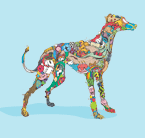An Irish greyhound is not just a dog, it's a finely trained athlete
For over 90 years, since the first races took place at Shelbourne Park Greyhound Stadium in 1927, Greyhound racing has been a way of life for many Irish families. The legacy of Greyhound racing, as well as providing entertainment for generations, is responsible for employing people throughout Ireland. Central to the sport are the athletes themselves - the Irish Greyhound.
Professional Irish Greyhounds
Professional racing greyhounds are the responsibility of the registered owners who are required legally to oversee the welfare, activity and whereabouts of their greyhounds.
Greyhounds are generally raised within a racing kennel environment. Each of these premises are required to adhere to welfare standards covering all aspects of their environment, feeding, treatment and breeding. These kennels are subject to regular inspections by the GRI Welfare Officers. Greyhounds are also inspected before racing by the Control Steward of the meeting and each race meeting is held with a Veterinary Surgeon in attendance.
The role of GRI during a greyhounds career
Greyhound Racing Ireland (GRI) - Rásaíocht Con Éireann - is a commercial semi-state body which is responsible for the control and development of the greyhound industry in the Republic of Ireland. Greyhound Racing Ireland, previously called the Irish Greyhound Board has licensed a total of fourteen tracks in the Republic, of which nine are owned and controlled by the organisation. The remainder are owned and operated by private enterprise.
Trainers, owners and breeders within the industry follow a strict Code of Practice, ensuring that greyhounds are the most regulated breed of dog in Ireland. GRI operations are strictly controlled under Government Legislation – Greyhound Welfare Act 2019.
The Irish Retired Greyhound Trust is a registered Charity funded by the Irish greyhound industry and has been in operation for over 20 years. The trust operates re-homing and adoption schemes not only in Ireland but worldwide in conjunction with several adoption partners. In 2020 the Irish Retired Greyhound Trusts assisted in almost 2,000 adoptions of Irish ex-racing greyhounds.
In 2019, Greyhound Racing Ireland (formally Irish Greyhound Board) set up a Greyhound Care Fund to support additional welfare initiatives including the setting up of a Greyhound Care Centre (where greyhounds are socialised and prepared for adoption), the setting up of a Care Line (where concerned members of the public can repo and an “Injuries at Tracks Recovery Scheme” provides owners and trainers with support for vet bills related to treatment for repair career-ending orthopaedic injury at a GRI licensed stadium.
In January 2021 a full greyhound traceability system was introduced, allowing the whereabouts of all greyhounds to be monitored by GRI from the start of its racing career to retirement.
Retired Irish Greyhounds
The average age for a greyhound to retire is 3-5 years and these retired athletes are a highly sought-after pet for many families. Due to their history, the dogs are very well socialised with other dogs and humans and as a result of their short hair they shed very little making them ideal for households with asthma or other allergies. A retired greyhound's life is very different to an active racing greyhound, not many people realise that as a breed they are actually quite lazy. Apart from access to a garden and 2 short walks, they are quite happy to sleep their days away perhaps dreaming of past racetrack glory!
Some greyhounds go on to become therapy dogs and others also get the opportunity to take part in meet and greets as part of the Irish Retired Greyhound Trust Ambassador Programme at the various GRI stadiums, which always proves popular with the public and gives the greyhounds a chance to show a side to themselves people don’t often get to see.


